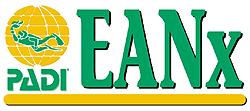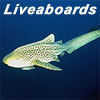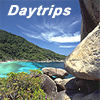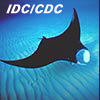TEC Diving in Phuket Thailand - Nitrox
What is Nitrox?
Nitrox is here to stay, but it's still a hot issue within the diving community. The debate is continuing among diving professionals, and we still face quite a few misconceptions. We will try to clarify some of the principles, logistic concerns and concept sand hopefully answer the most commonly asked questions regarding Nitrox used for recreational diving. Nitrox is nothing new. It has been used for military, commercial and research diving for more than thirty years. What is new is recreational diving with Nitrox.
We already have numerous labels such as "Enriched Air Nitrox", "EANx", "Safe Air", "Nitrox" and others. Nitrox, in simplest terms, is merely a mixture of nitrogen gas and oxygen gas. Air, therefore, is a naturally occurring Nitrox for all practical purposes. In diving, however, "Nitrox" usually means a nitrogen-oxygen mix other than normoxic air, normally with more than 21% oxygen.
To avoid confusion over the various possible Nitrox mixes one can create, we frequently refer to a Nitrox mix with a number reflecting the oxygen content, such as "Nitrox 36". This would mean a Nitrox mix of 36% oxygen and 64% nitrogen. The common names, "Nitrox I" / "EANx32" and "Nitrox II" / "EANx36", refer to 32% and 36% oxygen mixtures, respectively. These designations were created by the U.S. National Oceanic and Atmospheric Administration (NOAA), who chose to standardize and identify the most commonly used mixes of Nitrox gas.
The Purpose of Nitrox
As every certified diver knows, decompression limits and the potential for decompression illness are caused by the inert nitrogen component of breathing air. Nitrogen also causes nitrogen narcosis at deeper depths. Nitrox was conceived as a way to reduce the quantity of nitrogen breathed during a dive.
By replacing nitrogen in the breathing gas with oxygen, the diver's body absorbs less nitrogen for a given depth and time. Since the body metabolizes oxygen, in theory oxygen doesn't contribute to decompression illness, so a diver breathing EANx32, for example, should have longer no-decompression limits at a given depth than when breathing air (see table).
Depth
Air NDL
EANx 32 NDL
EANx 36 NDL

18 m
56 min
95 min
125 min

22 m
37 min
60 min
70 min

26 m
27 min
40 min
50 min

If decompression stops become necessary, a shorter decompression schedule would be required. Alternatively, the diver could base his decompression schedule as though he was breathing air, with the reduced nitrogen acting as an extra safety factor. In either case, nitrogen narcosis should theoretically be reduced somewhat compared to breathing air at the same depth.
Nitrox is not intended for extremely deep diving. As we will see, EANx32 becomes unsafe at depths not much greater than the recreational maximum limit of 40 meters, with higher oxygen mixes limited to even shallower maximum depths. Sometimes Nitrox becomes confused as a deep diving gas because commercial and technical divers frequently use Nitrox as a decompression gas following deep dives. However, these divers don’t begin using Nitrox until returning to shallower depths.
Is it safe?
Since the start more than thirty years ago, Nitrox has been used successfully by closely supervised and well-trained military, scientific, commercial and technical divers. Though it hasn’t had as much formal testing as air, the Nitrox safety record has been very good. Doppler tests have been made, with low or no detectable bubble formation when diving within table limits. In working dives, Nitrox isn’t associated with any higher DCI rate than diving with air. Used properly there doesn’t appear to be any greater risk diving with Nitrox than diving with air.
Using Nitrox
The key words are "when used properly". Diving with Nitrox provides longer no-decompression times compared to diving with air, but its use requires training to account for considerations not associated with recreational diving with air. The first consideration is that while there is only one type of air there are potentially 78 mixes of Nitrox with more than 21% oxygen. (Nitrox calculations normally assume that plus or minus 1% variation is tolerable in a Nitrox mix, so fractions of a percent are not treated as separate mixes. Nitrox with 31.6%, 32% and 32.3% oxygen are all considered EANx32). Each of the 78 mixes differs in no-decompression limits and decompression schedules.
The most common way to handle this is to convert the actual depth into an Equivalent Air Depth (EAD) that may be used with air tables. This is accomplished by using a simple formula. For example, at a depth of 25 meters using EANx36, the EAD would be 18,4 meters; the diver would use the no-decompression limits from that depth (rounded to 20 meters). Using the EAD concept, any Nitrox mix can be used with air tables. In the above example, Nitrox’s decompression advantage become immediately noticeable: 45 minutes no-decompression time is available at 25 meters, compared to only 29 minutes using air, depending upon the air table used. Alternatively, the diver could plan the dive as an air dive, creating a 16-minute safety factor.
To simplify Nitrox use, Nitrox tables have been developed. NOAA released tables for EANx32 in 1978, and for EANx36 in the early 1980s; these tables are used exactly like the standard U.S. Navy tables. In fact, these tables are simply the U.S. Navy tables rewritten with the actual depth replaced by the calculated EAD. Besides these, other organizations, such as various Navies around the world, have Nitrox tables and finally PADI’s RDP32 and RDP36 were introduced to recreational divers in 1995/96. In using Nitrox tables the diver must be sure that he uses the appropriate table for the particular mix he will be breathing.
Oxygen Toxicity
Unfortunately, Nitrox’s nitrogen advantages are gained only at the price of oxygen disadvantages. When using Nitrox, exposure to dangerously high oxygen partial pressures becomes possible at depths far shallower than with air. Nitrox mixtures with more than 32% oxygen cannot even be taken to the 40-meter depth limit for recreational diving.
The problem is Central Nervous System (CNS) oxygen toxicity, which, depending upon exposure duration, becomes a potential risk when oxygen partial pressures exceed critical limits. A case of CNS oxygen toxicity causes the diver to convulse and lose consciousness, and may or may not be proceeded by warning symptoms. Convulsions are not dangerous themselves, but an unconscious diver will lose his regulator and drown.
Critical oxygen limits vary drastically with partial pressure. A diver can tolerate .6 Ata oxygen partial pressure for up to twelve hours without significant risk of CNS symptoms. At 1.6 Ata, which is the maximum acceptable p.p., the time is about 45 minutes, possibly shorter than the no-decompression limit of the equivalent air depth. The Nitrox diver monitors his p.p./time allowances to make certain he doesn’t exceed his "oxygen clock", in much the same way he watches no-decompression limits. Minimum surface intervals must be noted as well.
As the oxygen percentage in Nitrox increases, the depth at which the critical 1.6 limit is reached rises. When breathing air the diver reaches 1.6 Ata at 66.5 meters. Breathing EANx32 1.6 Ata is reached at 40.3 meters; and with EANx36, 34,6 meters. Below these depths, the risk of CNS oxygen toxicity goes up dramatically.
Equipment Considerations
With the increase in technical diving and Nitrox use, there have been quite a few conflicting reports about whether standard scuba equipment is compatible with Nitrox.
NOAA's policies since the 70s have been:
- Standard air equipment, except the tank, may be used with any Nitrox mix, which has 40% or less oxygen without any modification.
- Equipment being used with mixes with more than 40 % oxygen, OR used for oxygen mixing must be oxygen compatible.
This means that for Nitrox mixes with 40 % or less oxygen, which are the most common mixes, a Nitrox diver can use the same equipment that he uses for air diving. The tank is an exception to the 40% guideline, and needs to be oxygen compatible regardless of oxygen content in the Nitrox. The reason the tank must be oxygen compatible is that a common method for mixing Nitrox is partial pressure mixing. This is done by adding 100% oxygen to the cylinder, then topping of with air that’s filtered to oxygen compatible standards. Even if the final mix may be less than 40% oxygen, exposure to 100% oxygen during mixing requires oxygen compatibility.
Besides oxygen compatibility, Nitrox tanks should be clearly marked to avoid confusion with air tanks. This is important considering that using a mix with more than 32 % oxygen, a diver can exceed the maximum oxygen depth limit while within the traditional 40-meter recreational depth limit.
Nitrox also requires at least one specialized piece of equipment: the oxygen analyzer. While the Nitrox diver doesn’t need to own one, the diver must confirm the mix’s oxygen content personally after the tank has been filled. This safety procedure ensures use of the correct EADs and calculation of oxygen p.p.
Mixing Nitrox
Mixing Nitrox isn’t as simple as pumping compressed air. In fact, while the air in a typical dive store meets the standards for compressed air diving, it frequently does not meet the higher standards required for mixing Nitrox. This means that even an oxygen compatible cylinder with oxygen already in it cannot simply be topped off with air from a typical dive store compressed air system. Doing so actually creates a risk of fire or explosion.
To avoid these complications, Nitrox diver training emphasizes these points; the Nitrox diver learns that the typical dive store isn’t capable of providing Nitrox (yet). Specialized dive stores and operations have and use appropriate Nitrox mixing equipment. The point is that safe Nitrox mixing requires special equipment, and like Nitrox diving, requires special training.
Nitrox Courses
 Diving with a Nitrox requires training to account for considerations not
normally associated with recreational air diving. PADI's Enriched
Air Nitrox Course addresses these considerations and teaches
you how to benefit the most by diving with Nitrox. In addition the
PADI Enriched Air Instructor
Course teaches the PADI Instructor how to successfully organize,
plan and market Nitrox training for recreational divers.
Diving with a Nitrox requires training to account for considerations not
normally associated with recreational air diving. PADI's Enriched
Air Nitrox Course addresses these considerations and teaches
you how to benefit the most by diving with Nitrox. In addition the
PADI Enriched Air Instructor
Course teaches the PADI Instructor how to successfully organize,
plan and market Nitrox training for recreational divers.
As a certified Nitrox Diver you can enjoy Nitrox
Diving on our liveaboard cruises and day trips, adding a new dimension to your diving adventures.

Dive Asia - Phuket Thailand
Office Address: 8/30 Soi Yodsanee, Chalong, Phuket 83150, Thailand
Phone: +66 (0) 818948588 or 0899736005
Visit us at one of our Offices: (Google Map)
Email:
Website: www.diveasia.com
24 Hour Hotline: +66 (0) 818948588


















